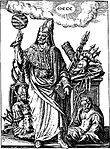
Back متون هرمس Arabic Corpus Hermeticum Catalan Corpus Hermeticum Czech Corpus Hermeticum German Corpus hermeticum Esperanto Corpus hermeticum Spanish متون هرمس Persian קורפוס הרמטיקום HE Corpus Hermeticum Croatian Corpus Hermeticum Italian
You can help expand this article with text translated from the corresponding article in Dutch. (March 2022) Click [show] for important translation instructions.
|
| Part of a series on |
| Hermeticism |
|---|
 |

The Corpus Hermeticum is a collection of 17 Greek writings whose authorship is traditionally attributed to the legendary Hellenistic figure Hermes Trismegistus, a syncretic combination of the Greek god Hermes and the Egyptian god Thoth.[1] The treatises were originally written between c. 100 and c. 300 CE,[2] but the collection as known today was first compiled by medieval Byzantine editors. It was translated into Latin in the 15th century by the Italian humanist scholars Marsilio Ficino (1433–1499) and Lodovico Lazzarelli (1447–1500).[3]
Although the Latin word corpus is usually reserved for the entire body of extant writings related to some author or subject, the Corpus Hermeticum contains only a very small selection of extant Hermetic texts (texts attributed to Hermes Trismegistus, commonly known as Hermetica). Its individual treatises were quoted by many authors from the second and third centuries on, but the compilation as such is first attested only in the writings of the Byzantine philosopher Michael Psellus (c. 1017–1078).[4]
Following their translation into Latin by Ficino and Lazzarelli, the Corpus Hermeticum greatly influenced the Western esoteric tradition. It was especially considered to be important during the Renaissance and the Reformation, in which Hermeticism would often function as a type of intermediate position between Christianity and paganism.[5] Hermes' perceived antiquity ensured that any writing attributed to him would take an important place in Ficino's doctrine of the prisca theologia ('ancient theology'), which affirms that a single, true theology exists that is present in all religions and that was given by God to humankind in the distant, primeval past.[6]
- ^ A survey of the literary and archaeological evidence for the background of Hermes Trismegistus in the Greek Hermes and the Egyptian Thoth is found in Bull 2018, pp. 33–96.
- ^ Copenhaver 1992, p. xliv; Bull 2018, p. 32. Earlier dates have been suggested, most notably by the modern historians Flinders Petrie (500–200 BCE) and Bruno H. Stricker (c. 300 BCE), but these suggestions have been rejected by most other scholars (see Bull 2018, p. 6, note 23)
- ^ Copenhaver 1992, pp. xl–xliii.
- ^ Copenhaver 1992, p. xlii.
- ^ Ebeling 2007, p. viii.
- ^ Ebeling 2007, pp. 61–64.
© MMXXIII Rich X Search. We shall prevail. All rights reserved. Rich X Search